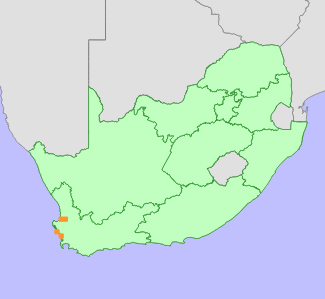|
Scientific Name | Lampranthus stanfordiae L.Bolus |
Higher Classification | Dicotyledons |
Family | AIZOACEAE |
National Status |
Status and Criteria | Endangered B1ab(ii,iii,v) |
Assessment Date | 2008/04/10 |
Assessor(s) | N.A. Helme, C. Klak & D. Raimondo |
Justification | EOO 4900 km², a rare species known to occur at only three locations. It is declining due to ongoing habitat loss to alien plant invasion, agriculture and coastal development. |
Distribution |
Endemism | South African endemic |
Provincial distribution | Western Cape |
Range | Redelinghuys to Mamre. |
Habitat and Ecology |
Major system | Terrestrial |
Major habitats | Atlantis Sand Fynbos, Hopefield Sand Fynbos, Leipoldtville Sand Fynbos |
Description | Well-drained acid sands in fynbos. |
Threats |
| Invasive Alien Species (direct effects), Habitat loss |
Population |
Population trend | Decreasing |
Assessment History |
Taxon assessed |
Status and Criteria |
Citation/Red List version | | Lampranthus stanfordiae L.Bolus | EN B1ab(ii,iii,v) | Raimondo et al. (2009) | |
Bibliography |
Goldblatt, P. and Manning, J.C. 2000. Cape Plants: A conspectus of the Cape Flora of South Africa. Strelitzia 9. National Botanical Institute, Cape Town.
Raimondo, D., von Staden, L., Foden, W., Victor, J.E., Helme, N.A., Turner, R.C., Kamundi, D.A. and Manyama, P.A. 2009. Red List of South African Plants. Strelitzia 25. South African National Biodiversity Institute, Pretoria.
|
Citation |
| Helme, N.A., Klak, C. & Raimondo, D. 2008. Lampranthus stanfordiae L.Bolus. National Assessment: Red List of South African Plants version 2024.1. Accessed on 2025/12/12 |
 Comment on this assessment
Comment on this assessment


